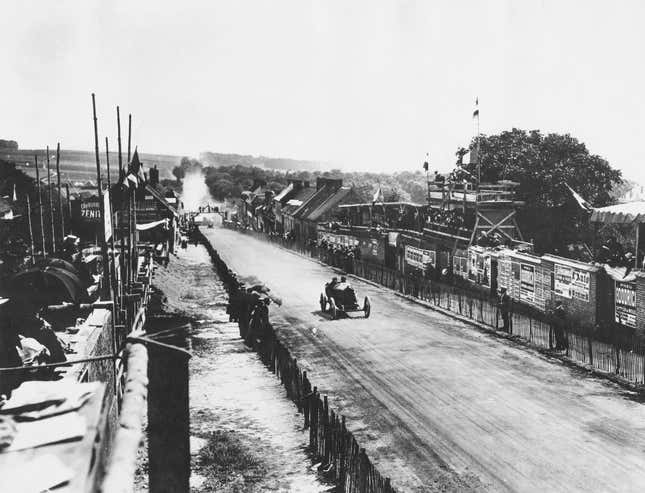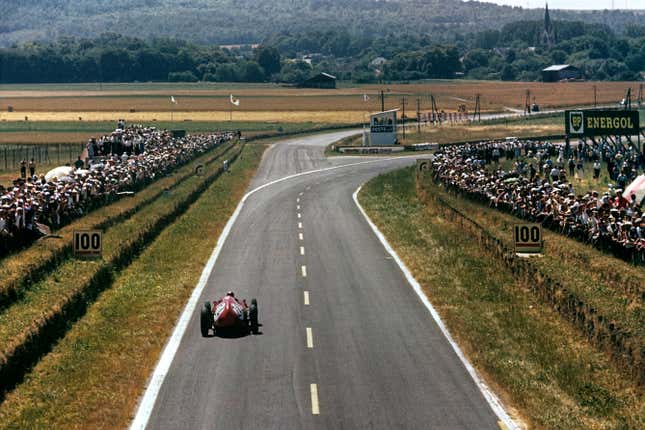The story of sparkling wine in motorsport tends to start in the same place: with that first accidental champagne spray by Jo Siffert on the podium for the 24 Hours of Le Mans, and then Dan Gurney following suit intentionally the year after. That, though, is only part of a story that had spanned decades prior to that first bubbly shower — and it’s a story that has evolved ever since.
But that story started far earlier.
Motorsport’s roots begin to hint at just why sparkling wine might have become a racing fascination. In the late 1800s, France hosted the first sanctioned automobile race, the Paris-Bordeaux-Paris rally. That route places the competition right in the heart of wine country — and, as many early competitors were the ultra-wealthy folks who could actually afford to purchase and maintain early vehicles, it would be no shock to find those gentleman racers had a fine taste in fermented grape juice.
In fact, back in the early days, it was also entirely legal to sip on a bottle of the beverage for hydration purposes. Back in 1913, Jules Goux of Valentigney, France cruised to an Indy 500 victory thanks to a little added power from the bottles of champagne he allegedly drank throughout the duration of the event.

After he slashed a tire on the 25th lap of what was then a grueling multi-hour endurance race, Goux allegedly leaped from the car and exclaimed, “Donne moi une bouteille de vin, ou je suis fini” — fetch me a pint of wine, or I’m done.
One of Goux’s crew members — who unsurprisingly, had no wine on hand — dashed into the crowd to commandeer a few bottles from a group of wealthy Pittsburgh spectators. Goux immediately broke open the bottle on the pit wall and took a healthy sip before he jumped back in the car. At every pit stop after, he and his riding mechanic imbibed. Historians debate just how much Goux and his mechanic actually drank that day (the numbers range anywhere from just a few sips to six entire pints), but the story has since gone down in history as one of the first big engagements between champagne and motorsport. (Drinking while racing was later banned during the Indy 500.)

On the continental side, champagne began to play an even bigger role. In 1932, the French Grand Prix was first hosted at Reims-Gueux, though the track was known for hosting other non-championship events beginning in 1925. The track was made up of rural public roads in France’s Champagne region, and as you can imagine, sparkling wine quickly became a critical part of the event — although not while driving.
In author Robert Daley’s book Cars at Speed, the French Grand Prix comes across as one of the most desirable events on the calendar thanks to its generous prizes. The purse for that one event was generally larger than the prizes at any other race, but the region’s local beverage also played a significant role.
“All week before the race the drivers shoot for cases of champagne which are put up by the organizers as prizes for fastest practice laps, and first lap of the day over a specified speed,” Daley wrote. “Usually there are three or more such prizes of 100 bottles each.”

According to Daley, this made the event particularly exciting. Drivers actually showed up early to dutifully log as many practice laps as possible in hopes of coming away with that day’s champagne prize. Meanwhile, snack vendors sold champagne in droves to spectators, and even journalists were offered the beverage while they worked. Daley wryly notes, “The fact that relatively few sober words have been written about Grands Prix at Reims, accounts in part for the race’s continuing tradition.”
Race fans tend to think of Formula 1 in particular as being the home of the champagne celebration, and it was in fact at a Formula 1 race where the first recorded bottles of champagne were dedicated to podium finishers. In 1950, at Reims-Gueux’s first-ever Formula 1 Grand Prix in the sport’s first season, Juan Manuel Fangio was awarded a bottle of Moët & Chandon that had been donated by the winery. Soon, the winemaker began to provide bottles to winners of other races, and it quickly became customary for winners to expect a refreshing bottle when they climbed from their cars.
But it still took about 15 years before anyone thought to celebrate with their champagne beyond drinking it. This is where the dueling Siffert and Gurney myths come into play. In 1966, Jo Siffert and teammate Colin Davis had won the grueling 24-hour battle that is Le Mans; as the two stood at attention during the national anthem, something happened. It’s still not clear whether the bottle was shaken, or if it had simply gotten too hot, but the cork on the Siffert’s bottle launched into the air and doused the crowd in fizz.
Perhaps American racer Dan Gurney remembered Siffert’s accidental spray the following year, when he ascended to the top step of the Le Mans podium with A. J. Foyt. The two Americans had just accomplished something stunning: They had become the first — and as of 2023, the only — all-American team to win the race. American drivers (Gurney and Foyt) behind the wheel of an American car (the Ford Mk IV) entered by an American team (Ford Motor Company, in partnership with Shelby American). Every single overall record was broken that year, and it warranted a spectacular celebration. Gurney shook up the bottle, popped the cork, and started spraying.

“We were up there celebrating, and everyone was up there, Michael Parkes from Ferrari and all the Ford people,” Gurney recalled in 2017. “We didn’t call him Henry II, we called him ‘Hank the Deuce.’ He was an imposing figure and if he looked at you the wrong way, you kind of shriveled up and tried to disappear. He was there with a new bride, I think, on their honeymoon and when I started spraying him, I’m not sure he liked it or not, but he was a good sport about it and we had a wonderful time spraying champagne, A.J. and I both.”
That one action entirely changed the course of motorsport podium celebrations. Suddenly, every winner of every race wanted to take part in the fizz-spraying competition to commemorate their victory. A tradition was born — not just of the champagne spraying, but of champagne waiting in the wings for the winner of many of history’s most notable races.

But in the Formula 1 world, things have recently changed. After decades of champagne use, that specific beverage is gone, replaced instead by an Italian sparkling wine called Ferrari Trento.
It’s pretty common for “champagne” to be the catch-all term for sparkling wine, but there are key differences. The easy answer is that sparkling is only champagne if it’s made in the Champagne region of France. If you really want to get into the nitty-gritty, champagne is also distinguished from other sparkling wines by its grape selection (Chardonnay, Pinot Noir, and Pinot Meunier, solo or in various combinations) and its production method (méthode champenoise, or the traditional method). Generally, if those three conditions are all satisfied, then the sparkling wine in your glass can be called champagne. Other forms of sparkling wine that utilize other grapes, come from other regions, or are made with different production methods include cava, crémant, prosecco, sekt, lambrusco, franciacorta, and more.
Because Ferrari Trento is Italian, it obviously can’t be called champagne — but that doesn’t make it any less delicious beverage. While it does utilize the méthode champenoise and is made of Chardonnay grapes, its vineyards are located on the Trentino mountains of northern Italy, which offers a different flavor profile when compared to a Champagne-made champagne.

F1 signed Ferrari Trento as its primary podium beverage provider back in 2022; on its face, that doesn’t seem like anything particularly newsworthy — but it does highlight F1’s recent evolution. When American company Liberty Media bought out the sport from Bernie Ecclestone, it kicked off a trend of innovation that saw things like the introduction of Drive to Survive and a growing number of American F1 events. The goal has largely seemed to be preserving F1’s prestigious heritage while also innovating toward the future.
On its face, a different sparkling wine producer doesn’t seem like a terribly big deal, but F1’s partnership with Ferrari Trento has upended countless traditions that were developed in Grand Prix racing. France is no longer considered the sole domain of good sparkling wine, nor is champagne the only sparkling wine that comes to mind. It makes sense to revolutionize the sport’s signature wine, even if it does seem like a minor detail. After all, success in motorsport is defined by infinitesimal changes and marginal gains.

